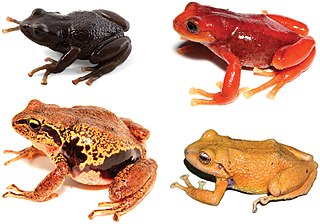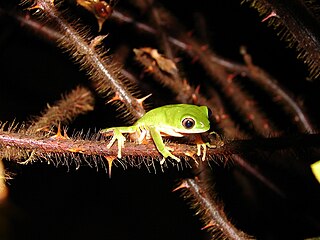
Hylidae is a wide-ranging family of frogs commonly referred to as "tree frogs and their allies". However, the hylids include a diversity of frog species, many of which do not live in trees, but are terrestrial or semiaquatic.

Hyalinobatrachium is a genus of glass frogs, family Centrolenidae. They are widely distributed in the Americas, from tropical Mexico to southeastern Brazil and Argentina.

Chiasmocleis is a genus of microhylid frogs. They are found in tropical South America north and east of the Andes. Their common name is humming frogs or silent frogs, the latter referring to the formerly recognized Syncope.

Hyloscirtus is a genus of Neotropical frogs in the family Hylidae. This genus was resurrected in 2005 following a major revision of the Hylidae, with the distinguishing features being 56 transformations in nuclear and mitochondrial proteins and ribosomal genes. Of these species, 28 species, previously placed in the genus Hyla, were moved to this genus. The fingers and toes of these frogs have wide dermal fringes.
Nymphargus pluvialis is a species of frog in the family Centrolenidae. It is known from the area of its type locality, Pistipata, Río Umasbamba, in the Huayopata District of the Cusco Region of Peru as well as La Paz, Bolivia. Its common name is Pistipata cochran frog, although it no longer is included in the genus Cochranella.

Callimedusa atelopoides is a species of frog in the subfamily Phyllomedusinae. It is known from Amazonian Bolivia, Brazil, and Peru, and is likely to be found in adjacent Colombia and Ecuador. Common name toady leaf frog has been proposed for it.
Callimedusa baltea is a species of frog in the subfamily Phyllomedusinae. It is endemic to the western slope of the Serrania de Sira, Department of Huánuco, Peru. Common name purple-sided leaf frog has been proposed for it. The specific name baltea is Latin for "border" and refers to the salmon line that separates the dorsal and ventral colors of this frog.
Callimedusa duellmani is a species of frog in the subfamily Phyllomedusinae. It is endemic to Peru and is only known from its type locality near Balzapata, upper Chiriaco River, in the Department of Amazonas. The specific name duellmani honors William E. Duellman, an American herpetologist. Common name purple and orange leaf frog has been proposed for it.
Callimedusa ecuatoriana is a species of frog in the subfamily Phyllomedusinae. It is endemic to Ecuador and known from the Amazonian slopes of the Andes in the Morona-Santiago Province as well as from Cordillera del Condor in the Zamora-Chinchipe Province. Common name Agua Rica leaf frog has been proposed for it.
Lynchius nebulanastes is a species of frog in the family Strabomantidae. It is endemic to north-western Peru where it is known from the vicinity of its type locality, El Tambo, on the western slope of the Cordillera de Huancabamba, Piura Region. Common name Canchaque Andes frog has been coined for it.

Engystomops coloradorum, also known as Colorado dwarf frog, is a species of frogs in the family Leptodactylidae. It is endemic to the Pacific lowlands and foothills of the Andes in the Pichincha and Santo Domingo de los Tsáchilas Provinces, Ecuador.

Nymphargus is a genus of glass frogs in the subfamily Centroleninae, which was established in 2007. They are distributed in the Andean slopes of Colombia, Ecuador, Peru, and Bolivia. They are characterized by lacking webbing among the outer fingers, lacking humeral spines in adult males, and having a lobed liver covered by a transparent hepatic peritoneum. They can be more specifically characterized as having a head that is darker green than the body, there being yellow spots surrounded by black on head and body, upper eyelids are dark lavender. The conservation status of the Nymphargus frogs was largely believed to be critically endangered due to the minimal research done on this genus. Once the scope of the research was broadened the conservation status was able to be determined as being vulnerable. More frogs of different variations were found increasing the genus’ population.

Hyloidea is a superfamily of frogs. Hyloidea accounts for 54% of all living anuran species. The superfamily Hyloidea branched off from its closest relative, the Australobatrachia, during the mid-Cretaceous. The fossil evidence found during the Cretaceous-Paleogene extinction event could not determine the effects upon the frogs, due to the lack of fossils. Increased forestation erupted after this extinction, possibly leading to more arboreal adaptations of these anurans to be best suited for this habitat.

Hyloxalus is a genus of poison dart frogs, family Dendrobatidae. The genus is distributed in Central and South America, from Panama south to Peru, along with Venezuela, Colombia, and Ecuador. They also inhabit the eastern foothills of the Andes in Bolivia to Venezuela, east to the upper Amazon Basin.

Craugastoridae, commonly known as fleshbelly frogs, is a family of New World direct-developing frogs. As delineated here, following the Amphibian Species of the World, it contains 129 species. They are found from the southern United States southwards to Central and South America.

Pelodryadinae, also known as Australian treefrogs, is a subfamily of frogs found in the region of Australia and New Guinea, and have also been introduced to New Caledonia, Guam, New Zealand, and Vanuatu.

Engystomops is a genus of frogs in the family Leptodactylidae. They are known commonly as foam frogs or túngara frogs, though the latter name most commonly refers to Engystomops pustulosus. They are native to the Americas from southern Mexico south to the Amazon Basin.

Lynchius is a genus of frogs in the family Strabomantidae. The name honours herpetologist John D. Lynch. The distribution of Lynchius is restricted to the Cordillera Oriental in southern Ecuador and Cordillera de Huancabamba in northern Peru.

Niceforonia is a genus of frogs in the family Strabomantidae found in northern South America. The name refers to Nicéforo María, Colombian herpetologist.

Pithecopus is a genus of frogs in the subfamily Phyllomedusinae. Species of the genus Pithecopus are found in tropical South America east of the Andes, from southern Venezuela to northern Argentina. Resurrected from the synonymy of Phyllomedusa in 2016, it corresponds to the former Phyllomedusa hypochondrialis group. Its sister group is Callimedusa.















